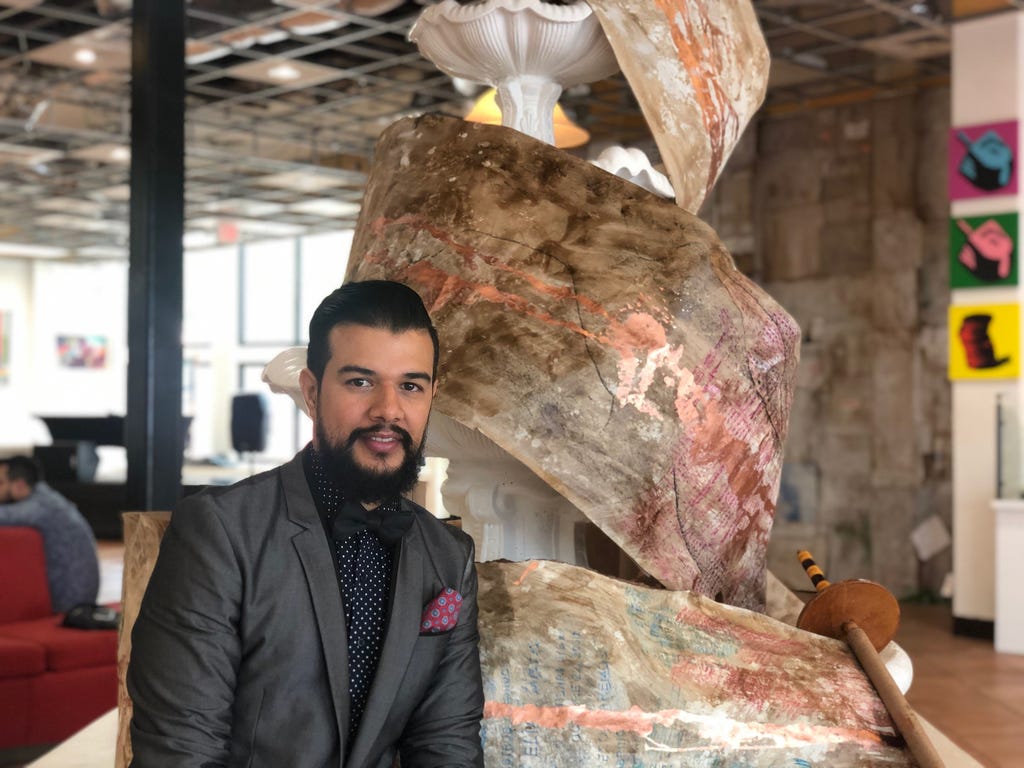The Jewish contribution to the famous art fair this month showcased just how diverse the community is: ‘I finally understood why we never celebrated Christmas!’
MIAMI BEACH — As collectors from across the globe converged on Miami last week for the world-famous Art Basel art fair, Jewish artists made their mark by depicting their personal stories of blended backgrounds and immigration.
The Jewish Art Salon, the largest Jewish visual art organization in the world, sponsored the JADA Art Fair & Artist-in-Residence Program at the Basel event; its exhibition explored themes such as Jewish immigration, persecution, the Diaspora, redemption and the return home
These issues hit close to home for Brazilian-born artist Jonatas Chimen, whose works were a big part of the display at this branch of Art Basel, which also takes place in Hong Kong and Basel, Switzerland.
“At the age of 16 my parents brought me here to this country,” he told Haaretz on the Sunday morning the exhibit opened to the public. “I already had an immigrant background in Brazil as my grandmother — she’s Spanish.”

But growing up, Chimen didn’t know he was Jewish. With ancestry dating back to the Spanish Inquisition, his family had adopted a lifestyle similar to that of crypto-Jews hiding their Judaism while practicing it: Kosher households were referred to as “clean” and Chimen was always instructed to say he was Catholic.
When he moved to the United States and began asking questions and researching his ancestry, pieces fell together and Chimen discovered his Judaism.
“Once I found out everything, it was like a bomb had just exploded on top of my head,” he said. “I understood everything, why we’re so weird, why we never celebrated Christmas!”
- Mizrahi Identity Politics Heads to Harvard Law School With a Conference
- Can the World’s Most Famous Anti-war Painting Help Inspire Coexistence in Israel?
- The Kaffiyeh Art Exhibit That’s Making Israel Tremble
His family’s journey, the search for his roots, has become his inspiration. His narrative-based paintings that were displayed depict his family’s journey to mainstream Judaism. The first ones, on dark canvas, show a crumpled prayer shawl entangled by a red and yellow string, representing the colors of Spain. But the talit gradually overcomes obstacles until the canvas becomes light-filled and blended — Chimen now feels part of the Jewish community.

nother installation, titled “In Thy Tent I Dwell,” invites visitors to enter a nomad tent made out of shipping boxes. On the inside, the floor becomes sand and the tent is covered with scanned copies of the documents Chimen has collected on his ancestry over the years.
Immigration, he says, is simply part of his DNA. “We’re so lucky to be here in the U.S., but don’t take it for granted,” he said. “If you don’t participate in the decisions, in the politics, it’ll be gone.
As he put it, “It’s our obligation as good proud Americans to criticize and to defend our right to say what we think” — and he regularly repeats this slogan to his students at a local college.
Until a month ago the JADA exhibit’s space, a large light-filled room, was an abandoned supermarket that was dangerous to enter. The initiative, the Jewish Art Salon wrote, “boldly recognizes the invaluable role of Jewish folklore, history, allegory, and even of religion, in the process of making and experiencing contemporary art.”

On the room’s back wall, three cotton canvases filled with patterns in red and black oil by Olivia Guterson also tell a story of mixed heritage. Born in New Mexico to a Jewish father and an African-American Catholic mother, Guterson’s upbringing is a source of inspiration for her.
“My grandma on my dad’s side was a prolific quilter,” she said. “Her family had survived the Holocaust and she was mostly silent about those things. It took a lot of time sitting with her and helping her kind of cut out triangles, just listening, and I really got a deep appreciation for patterns and stories.”
The three hand-painted pieces of fabric aren’t displayed flat in this space, they’re molded into shapes and pinned to the wall. The details of the motifs each represent something for Guterson. One of them is inspired by a stitch on one of her late grandmother’s dresses.
“I’ve always been fascinated by migration and immigration,” she said. “I really wanted to create a hybridization of different patterns that meant a lot to me and captured my family’s stories and our travels and reinterpret them in a way that I’m making a place for myself who has these complex identities. That means so much to me.”

Guterson, who is also an activist and community organizer, added that she is “deeply distraught” by the current immigration crisis.
“I think breaking up families is such a violent act,” she said. “That’s something I’m deeply passionate about. Being mixed, or being a part of this Diaspora, is a larger intersecting story that’s the story of this country.”
She added: “Patterns are something that translates to everybody, so something I’m really grateful for about art is that I have this outlet to express myself and get all this stuff out so I can show up in the world as a moral whole person.”
Other artists featured included Dana Blickensderfer and Nathan Beard, whose work also carries a message about immigration. Not all the artists at the JADA exhibit’s space are Jewish, but the topic is a central element of their work.
The exhibit, also sponsored by the groups FeSeLa, the Sephardic Congregation of Florida and the Tribe, included workshops for the community to participate in, not to mention a Saturday night party dubbed “Shabbasel.”


Recent Comments